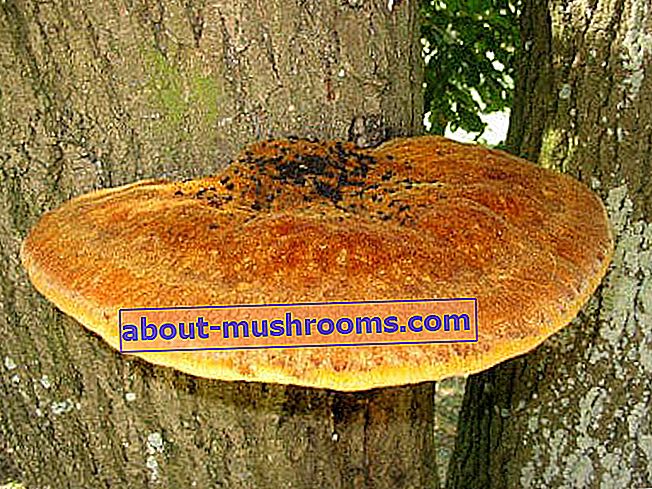Bristly-haired polypore (Inonotus hispidus)
- Other names for the mushroom:
- Bristly polypore
Synonyms:
- Bristly tinder fungus;
- Boletus hirsutus;
- Boletus spongiosus;
- Boletus velutinus;
- Hemidiscia hispida;
- Phaeoporus hispidus;
- Polyporus hispidus;
- Xanthochrous hispidus.

The bristly-haired polypore (Inonotus hispidus) is a fungus of the Gimenochetes family, belonging to the Inonotus genus. It is known to many mycologists as a parasite of ash trees, which provokes the development of white rot on these trees.
External description
The fruiting bodies of the bristly-haired tinder fungus are caps, annuals, grow mainly singly, sometimes they are arranged in a tiled pattern, 2-3 caps at once. Moreover, the fruiting bodies grow together widely with the surface of the substrate. The size of the cap of the bristly-haired tinder fungus is 10 * 16 * 8 cm. The upper part of the caps of young mushrooms is characterized by a reddish-orange color; as it ripens, it becomes red-brown and even dark brown, almost black. Its surface is velvety, covered with fine hairs. The color of the edges of the cap is uniform with the color of the entire fruiting body.
The flesh of the bristly tinder fungus is brown, but lighter near the surface along the edges of the cap. It has no zones of various colors, and the structure can be characterized as radially fibrous. On contact with some chemical components, it can change its color to black.

In unripe fungi, the pores in the hymenophore are characterized by a yellowish-brown tint, have an irregular shape. Gradually, their color changes to rusty brown. There are 2-3 disputes per 1 mm of the area. The hymenophore is of a tubular type, and the tubules in its composition have a length of 0.5-4 cm, and an ocher-rusty color. The spores of the described type of fungi have an almost spherical shape, can be broadly elliptical. Their surface is often smooth. Basidia consist of four spores, have a broad-headed shape. The bristly-haired polypore (Inonotus hispidus) has a monomytic hyphal system.
 Season and habitat of the fungus
Season and habitat of the fungus
The range of the bristly-haired tinder fungus is circumpolar, therefore, fruiting bodies of this species can often be found in the Northern Hemisphere, in its Temperate region. The described species is a parasite and affects mainly trees belonging to broad-leaved species. Most often, bristly tinder fungus can be seen on the trunks of apple, alder, ash and oak trees. The presence of the parasite was also noticed on birches, hawthorn, walnut, mulberry, ficus, pear, poplar, elm, grapes, plum, fir, horse chestnuts, beeches, euonymus.
Edibility
Inedible, toxic. It provokes the development of putrefactive processes on the trunks of living deciduous trees.

 Season and habitat of the fungus
Season and habitat of the fungus